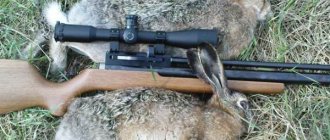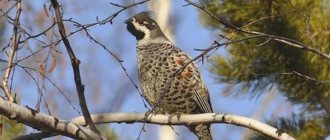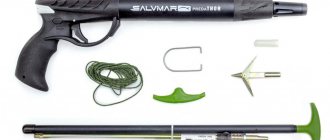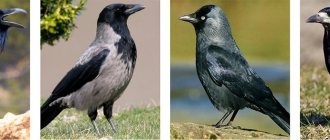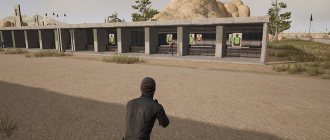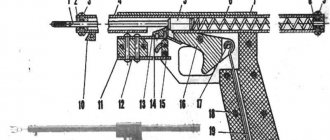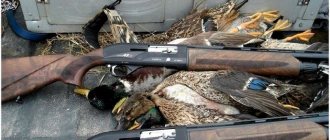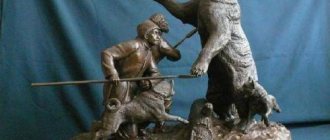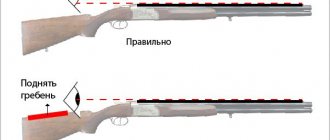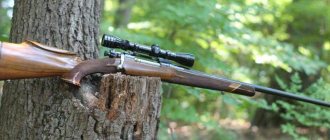We consider exclusively spring hunting for displaying black grouse males using hunting crossbows. In Russia, hunting with throwing weapons is still prohibited, in the European Union - in general, any spring hunting is prohibited. But not everything is so sad, the legislation is different everywhere. In Belarus, for example, you can legally take many species with the help of arrow throwers - from elk to the hero of our story.
The black grouse is a medium-sized bird, reaching the size of a domestic chicken. The male is usually larger than the female; The average weight of a rooster is 1.2-1.5 kg, a black grouse is 800-1000 g. An adult rooster has black plumage with a blue sheen, red eyebrows above the eyes, a black beak, dark brown fingers, and a lateral horn-shaped comb-like fringe. The underwings and undertails are white. Strongly cut tail; the outer tail feathers are beautifully curved to the side, resembling a lyre.
What kind of pigeons can you see in Russia?
Dove hunting is made more difficult by the fact that these are individuals that come in a wide variety. Thus, there are more than 250 species of wild pigeons, if you do not take into account decorative and postal species. The bird is not only a magnificent game, but also an excellent delicacy. The more widespread pigeons become, the more accessible they become to those who want to shoot them. Hunting for wild pigeons in the Russian Federation is carried out for various species.
- The wood pigeon is a pigeon, which is considered the most beautiful and largest representative, reaching a length of more than 50 cm with a weight of more than 500 g. The wood pigeon is found in almost all parts of the country, from coniferous forests to the city. In winter, the birds divide into pairs and begin to build nests. Pigeon hunting for wood pigeon is complicated by the vigilance and wariness of the birds and is considered a rather complex process. They often lead it near places where grain is collected, near oak trees, vineyards, and berry bushes. Such prey is considered the most desirable for everyone due to the size of the trophy.
- The rock pigeon is a species that can be found in every city. It is distinguished by its bluish plumage and sedentary lifestyle. Birds build nests at heights, choosing forest, rocky and mountainous areas or roofs. They feed on seeds and plants. Hunting for rock pigeons is not as common as in the previously described case.
- The turtle dove is a beautiful and most graceful species with brownish plumage and black stripes on the neck. The bird weighs less than 200 g, and its length barely reaches 30 cm. Pigeons live in forests and agricultural areas. Birds feed on plant foods.
- Klintukh belongs to the wood pigeons, and its distinctive feature is its rich blue plumage with a beautiful greenish tint. You can find nests in hollows, and the pigeons themselves in linden forests or beech groves. Hunting is complicated by the incredible caution of birds.
All those who hunt pigeons need to be prepared for the fact that it may not be possible to get the prey right away. Cautious and careful birds sense danger a mile away, so they fly away immediately.
Habitat and behavior of pheasants
The size of pheasants is almost 90 cm, and their weight is up to 2 kg or more. A beautiful long tail with more than 15 feathers attracts special attention from admirers of this family. Males are usually larger than females and have an iridescent color. Pheasants live in the territories of Central Asia and the Caucasus, as well as near the Amur and Volga rivers. In general, the species is very rare, so hunting these birds is prohibited in some regions. To ensure that the activity continues actively and there are fewer restrictions, specialists from hunting estates are engaged in artificial breeding of the family.
Pheasants spend all their time in thickets of bushes, but the main condition is that there must be bodies of water nearby. And only at night the birds are placed on tree branches to sleep. Their diet is varied: plants and berries, and sometimes even small worms and insects. The hunting process is most fruitful in the fall - it is during this period that pheasants grow up and begin to look for food on their own, sometimes emerging from dense thickets. If danger approaches, the bird takes off sharply vertically, and then, having calmed down a little, continues its flight calmly and evenly.
Avid hunters should be aware of the fact that sometimes a pheasant can fly almost a kilometer to confuse the trail. Their running speed is almost 40 km/hour, and at this speed the bird easily changes its flight path.
About the intricacies of observing wild pigeons
It is better to start hunting doves in late summer or early autumn. Only true and dedicated hunters give preference to catching a pigeon due to the fairly large amount of money and effort spent. However, many experts note that hunting a wild pigeon is interesting, exciting and very exciting. Game is found almost everywhere due to constant migration. The main techniques for hunting pigeons are:
- hunting at feeding and watering places;
- pigeon hunting from the approach;
- surge;
- using semolina;
- hunting pigeons with stuffed animals.
Any of the techniques requires careful preparation from a person. The preparatory stage decides how successful the hunt for wild pigeons will be. Preparation should begin with determining where pigeons live, what they eat, and what features they have. They can mostly be found near grain fields, meadows, farms, etc. It is important to correctly calculate how and when birds feed, what place they choose to rest and spend the night. It should be remembered that such calculations cannot be extended over time due to the frequent change of feeding and sleeping places by pigeons.
Anyone who has seriously decided to devote time to catching a pigeon needs to acquire binoculars and a monocular for observations. It is important to choose an observation location that matches the flight path of the pigeons. It is best if there are a large number of bushes and trees nearby, and the sun hits your back. In flat terrain, it is important to hide in a hole. It is equally important to camouflage yourself as much as possible so as not to frighten the pigeon again. Only those who hunt while fully camouflaged can succeed. That is why pigeon hunting is often accompanied by stuffed animals, which you have to make with your own hands, and their production is a very labor-intensive process.
The most important detail remains the choice of weapons. If a person hunts a wood pigeon, then it is better to use small ammunition; larger ones are suitable for a turtle dove. Hunting rifles must be flexible and light, because birds can easily change direction of flight. When using pneumatics, preference should be given to 22 gauge. In addition, pigeon hunting with a slingshot is quite common.
Hunting with air guns
Air hunting is not approved by all hunters, because the use of a real gun cannot be replaced by any pneumatic gun. For hunting, you need to choose an early time in the bird feeding areas. Wide fields become the preferred hunting areas. The time to use such weapons is at the end of summer and beginning of autumn, but hunting is only possible for gray pigeons. An important step is to purchase lightweight and durable equipment in the appropriate color.
A hunter of birds (pigeons) can even go out in sports low shoes, covering his head with an appropriate headdress with a visor. If you behave as carefully as possible, then by 12 noon even a novice hunter will be able to shoot 10-12 individuals.
Thus, hunting pigeons is a truly exciting process with many different subtleties and tricks. Everyone can choose the option that seems the safest and most interesting. If you follow the basic rules, the production will amaze you with its quantity, and the process will bring a lot of gambling pleasure.
About the types
How a person hunts pigeons is already clear, but what can be said about the characteristics of existing species of this difficult process?
- The watering place is held from the beginning of sunrise to 8 o’clock in the morning, when the pigeons leave the roost and head to the reservoir. Their gaze can even stop at an ordinary puddle. If you manage to find the right place, you need to prepare it by making a shelter. Due to the caution of pigeons and maintaining an open area, it is better to use stuffed animals or carry out it using a profile. An evening watering hole would be a good option, but you shouldn’t spend more than 2 days on it. Pigeons will recognize the hunter and quickly change one body of water to another.
- Pigeon hunting in feeding areas takes place in cereal fields and granaries, because the birds love to eat sunflowers, peas and wheat. Sometimes they occupy meadows and old gardens. Hunters should be at the edges of the field, but not inside, as there may also be other people or animals nearby. It is better to use stuffed animals placed along the border. Then the birds will fly towards them, and not stop in the middle. When a person hunts in this manner, shots should be fired from cover at nearby birds. The most important hunting accessory in this case is binoculars, which will tell you where the prey will fall.
- It is better to use the “approach” together with a partner or a trained dog. Hunters do not often use the approach method due to the timidity and caution of birds, because it is necessary not only to walk as quietly and carefully as possible, but also not to make unexpected movements. It will not be difficult to find downed game with the help of a dog or a landmark hung on a tall plant.
- The surge method is suitable for the period when the birds decided to rest in the trees and clean their feathers. In this case, hunters of up to 6 people must divide into pairs and walk to rest areas. The remaining hunters remain at the finish line, in the place where the birds will later be herded. Having seen people, the pigeons will lie low, waiting for the first to move on. After takeoff, they are fired upon by their partners.
- Using a decoy is suitable for beginners, because experienced specialists do not need to use special hunting tricks - they just need to make a mouthpiece with their palms. You need to start luring early in the morning or after 3 o’clock. An ideal place would be an area with lonely trees. Shots should begin as the birds approach. If they manage to sit on a tree, it will be difficult to shoot them.
Experts advise not to look directly at birds if they are spotted in watering and feeding areas. It is enough to glance at them, periodically casting glances, reducing the distance. When sneaking up, you may need to sit down, because pigeons can become easily alarmed. After waiting out the dangerous moment, you should resume movement, and if you crawl on all fours, success is guaranteed. Along with the decoy, you can try using a slingshot, which is quiet and compact.
And laughter and sin
Now such measures may seem extreme, but we should not forget that the history of the Olympic Games includes dozens of sports that at one time suffered the same fate. Some of them were considered inhumane, some were stupid, and some lost their popularity and simply faded away.
In the modern world, for example, it is impossible to imagine international competitions in shooting... pigeons! Surprisingly, this sport, included in the Games program for the first time in 1900, lasted right up until 1908. At first, the “athletes” competed in standard pigeon shooting with rifles. In 1904, in St. Louis, they stopped firing firearms, but they were replaced by bows and arrows, which the American Indians used to try to hit birds. And in 1908, the Olympians again began to destroy the innocent birds of the world. Moreover, the competitions were held not only in individual, but also in team competitions. This species was later condemned by the Olympic Committee and removed from the list of competitions.
Now we are absolutely normal about long and high jumps. Even the triple jump does not cause us any complaints. Few people know, but in 1900 in Paris, not only people, but also horses jumped long and high. Unfortunately, this undoubtedly promising sport was not continued. The jumping competitions and several other disciplines were lost. Along with standard competitions, until 1920, athletes competed in the long jump, high jump and standing triple jump.
The water sports program has also become depleted. In particular, only in 1900 in Paris, athletes fought for victory in such a discipline as swimming 60 meters under water. Each dive was punishable by penalty points. A similar sport, long-distance diving, fell into oblivion in 1904. The point of “plugging,” as it was called, was to swim as far as possible after jumping into the water without making any movements. The record, by the way, is 19 meters and 5 centimeters. Also in 1900, the Olympics lost another spectacular event - steeplechase swimming. At a 200-meter distance, athletes had to climb over a barbell, a boat, and then swim under this boat.
But the most amazing water sport can be called the “swim of Greek sailors” that took place at the first modern Olympic Games in Athens. The winner was the one who swam 100 meters faster than the rest... in full sailor's attire.
We can talk endlessly about funny sports that were excluded. Judge for yourself: balloon competitions, mail carriage races, fencing with sticks and many, many others, the names of which say little. For example: Jeu de paume, rocky, rock, rackets, Basque pelota, chovgan, la canne, glima.
Use of stuffed animals
Using stuffed animals is practically no different from using them on other animals. Due to the fact that stuffed pigeons are not as common as we would like, you will have to start making your own profile or stuffed animal from the skin of a live pigeon. When making attributes, it is important to ensure that the artificial birds look natural and depict a sitting individual. It is enough to put up to three stuffed animals in the chosen place (most often this is a sleeping or feeding place).
Reincarnators
But all these sports are not forgotten. Not long ago, a club for the “Development of Sports Excluded from the Olympics” was created in Germany. Its members set themselves a very ambitious task - to revive disciplines that began to fade after being excluded from the Olympic list.
The organizers even hold international competitions in these sports and plan in the long term to make them as popular as the Olympics. So those who want to plunge into the atmosphere of one of the most absurd Olympics in history, which took place in Paris in 1900, have a chance to do so at the World Games of Former Olympic Sports.
Varieties of wild pigeons
Looking at the urban rock pigeon, would you think that it is wild? And far from the only one. In nature, there are more than 290 species of pigeons, not counting decorative and homing ones - their number exceeds 800 species.
Wild pigeons are excellent game for hunting, and their meat is a delicacy. Moreover, the wide distribution of these birds makes them an accessible and popular target for hunters.
In the regions of Russia, 12 species of pigeons predominate, of which the most common are:
Wood Pigeon
This species is considered one of the most beautiful and largest representatives. It also has other names, for example, vityuten. The length of the body reaches 45-50 cm, the tail - 15-17 cm, and the weight - as much as 650 g. The bird has a significant wingspan of 70 cm, which clap loudly when taking off.
The wood pigeon is a common bird, lives in coniferous, deciduous and mixed forests, and sometimes appears in cities.
After the winter period, wood pigeons split into pairs and build nests above the ground. These wild pigeons are alert and very wary. If they feel danger near their nests, they will immediately leave them and, most likely, forever. This is why wood pigeon hunting is not easy.
Outside the nesting period they live in flocks.
Wood pigeon hunting is carried out near grain harvesting and cultivated fields. These birds feed on grain, worms, and caterpillars. They love to perch in oak trees in flocks and feast on acorns. In summer and autumn they prefer berries, birds can be found among vineyards, rosehips and hawthorns.
Hunting for the wood pigeon is the most desirable, because it is the largest of the pigeon trophies.
Rock pigeon
This is the same pigeon that is found at every step in cities. Naturally, its plumage is gray. Outwardly, it is similar to its forest counterpart, although its tail is darker.
As a rule, he leads a sedentary lifestyle. The nests are nested at a sufficient height - in forest areas these are rocks and mountains, in cities they choose roofs and attics.
The diet mainly consists of plant seeds.
Turtle Dove
A beautiful and graceful species of pigeon can rightfully be called the turtle dove - the owner of gray-brown plumage with distinct black lines on the back of the neck and a light edging on the tail.
The turtle dove is very small, weighs 150-200 g and is about 30 cm long.
They live in forests and near agricultural lands. They prefer plant foods.
Klintukh
This is predominantly a wood pigeon. It is distinguished by its rich blue plumage, with a beautiful blue-green tint on the neck.
The nests are nested in tree hollows; the place to look for the clint is in a linden forest or beech grove.
The wood pigeon is also very careful. When threatened, it instantly takes off and hides.
Features of pigeon hunting
Although many hunters do not like dove hunting due to the high ammo consumption, it is a fun and challenging activity.
Such game can be shot throughout Russia, since pigeons make constant flights. True, limited by the norms established by region, from 5 to 15 birds on one hunter’s card.
Basic techniques for hunting pigeons:
- at a watering place;
- at the feeding site;
- from the approach;
- surge on vacation;
- with semolina;
- with a stuffed animal.
Preparation
To make pigeon hunting interesting and productive, you need to pay enough attention to the preparatory stage.
Before you hunt, you need to spend time identifying areas where birds live. As a rule, they are found near fields with cereals, in meadows, and farms. Next, you should find out in what mode the pigeons fly to feed and rest, and where the pigeons spend the night. Moreover, it is also not worth extending these observations, since wild pigeons often change their feeding and roosting places, and then you will have to start all over again.
For observations you will need binoculars and a monocular.
When choosing an observation site, take into account the position of the sun and the flight path of the birds. It’s optimal when the sun hits your back and there are bushes, trees, and copses around. If the area is flat, you can hide in a dug hole.
Camouflage is carefully chosen, as these birds are very careful and shy. Not only the body, but also the face should be covered with camouflage.
The chances of rich catch will be increased by working on stuffed animals, which are difficult to find on sale, so many hunters make them themselves.
Choosing a gun and ammunition
For the wood pigeon, small ammunition will be used - No. 5-6. It is better to shoot the turtledove No. 8-9. The gun chosen is flexible and light, since pigeons are very fast and, even when wounded, are capable of abruptly changing their trajectory.
If you take pneumatics, then the 22nd caliber (5.5 mm) is best suited.
Also, despite some skepticism, hunting with a slingshot is very effective and exciting.
How to find killed game
Due to its small size and feeding areas, a killed pigeon can be very difficult to find. Therefore, if the bird is far from the hunter, it is recommended to refrain from shooting, of course, provided that the hunt is not carried out in an open space.
After you have shot a pigeon, you should immediately go to the place where it fell. If you cannot find the dove, then you need to hang a bright cloth at the place where it fell, and continue searching in circles around it, constantly increasing the radius of the circle. The fact is that if you don’t hang a beacon, you can go quite far from the crash site and end up not finding anything.
Searching for downed birds with dogs is much more effective. They quickly find killed game and bring it to the owner. Of course, the best breed for finding and fetching birds is the Russian Hunting Spaniel. It not only effectively searches for and serves game, but also takes it out of the water.
Types of hunting
The main methods of hunting wild pigeons were mentioned above. Now let's look at them in more detail.
At the watering hole
Between sunrise and 8 a.m., birds leave their roosting areas and go to water bodies. At the same time, they can choose both open water and a puddle.
If you manage to find this place, then for hunting purposes you need to arrange a shelter there and hide in advance, before the birds arrive. Pigeons drink water very carefully and stay in open spaces. It is effective to use stuffed or previously shot birds.
It is also a good idea to hunt at an evening watering hole.
In any case, there is no point in shooting pigeons in one place for more than 2 days: they are very shy and will certainly find another body of water.
Hunting dates and methods
Almost everywhere birds are raised for shooting using artificial methods. As mentioned above, the pheasant hunting season usually falls from mid-October to the end of the year. At other times, shooting is prohibited. You should also know that some regions completely prohibit shooting pheasants.
In the midst of the hunt!
There are many different hunting options. Therefore, the most relevant and common ones should be described.
Tips from an experienced shooter
If you find pigeons sitting at a watering hole or feeding area, do not look at them directly. It is better to observe with peripheral vision or take short glances until you close the aiming distance.
Hunting with a slingshot does not create unnecessary noise and does not scare away all the game.
When sneaking up on birds, you must be prepared to quickly crouch if the pigeons become alarmed. After waiting for some time, you can move on. It's even better to go to them on all fours. The pigeons recognize the hunter and quickly fly away upon noticing him. As for other living beings, they barely react to them.
It is preferable to hunt pigeons in summer and early autumn.
Bird breeding
Before you start hunting, you should know about pheasant breeding. Breeding such exotics is quite a profitable and promising business. In addition, this is an interesting business that brings excellent income. Also, breeding can be started not in order to organize a hunt, but simply to obtain the products that the bird brings, namely meat and feathers. Also, breeding pheasants is a great way to decorate your garden.
A long time ago, pheasant hunting was available only to rich, royal individuals. It was from that time that the breeding of birds for the rich began. Then, of course, mass breeding of poultry for various purposes began. This activity has become a favorite activity for many, and every year it gains more and more popularity.
In addition, many hunting farms are happy to purchase birds for shooting at a certain time or for a planned hunt. After organizing a custom hunt, the owner of the birds receives an excellent income, and clients remain satisfied while hunting for prey.
Domestic pheasant
It is worth noting for new farmers who wish to use poultry farming as a business. Breeding pheasants must be planned and thought out, so you will need to take care of building the farm itself, not far from the place where the hunting takes place. It is also recommended to breed near large cities. In this way, it will be possible to optimize the costs of transporting birds and the products they provide. Thanks to optimization, breeding will quickly be able to fill your wallet with a large amount of funds.
Video
From our video you will learn about the secrets of hunting wild pigeons with decoy.
Traditional hunting for wild pigeons is a sporting type of hunting; even clay pigeon shooting was once carried out specifically for pigeons released from a basket. A plus to such a hunt is very tasty meat, juicier than hazel grouse and more aromatic than duck. But such a hunt requires from the hunter all his best qualities as a shooter, as well as excellent attention. Pigeons belong to the field game birds; hunting for them opens on the last Sunday of August, as well as for waterfowl. Spring hunts are prohibited, but summer hunts sometimes open in some regions, which is worth nostalgia about. Knowledge of the terrain and the behavior of birds, patience, attentiveness and shooting skills offhand - that’s all that is required from a hunter.
For what?
But along with sports that make you smile, there are a number of quite serious disciplines that could look decent even in this day and age.
No matter how funny it may sound, the world championships in tug of war are still held and gather an audience that even some football clubs of the Russian Premier League can envy, not to mention such Olympic sports as pistol shooting or archery competitions. Tug of war was eliminated only in 1920. Another type lasted a little longer - rope climbing. Olympians climbed under the dome of sports arenas at speed until 1932.
In 1900, the last time an Olympic champion was determined in such a popular sport as cricket, and four years later golf was also removed from the Games program. Four years later, in 1908, lacrosse. And just recently, standard baseball ceased to be an Olympic sport.
The fate of polo is surprising. Competitions on it were held only five times. Four times - every eight years and the last time this sport could be enjoyed at the XI Olympic Games in 1936 in Berlin.
But what can we say about polo, when rugby, popular even in Russia, “lasted” only until 1924.
And, by the way, the blow that could be dealt to cycling will not be the first loss in the list of competitions on “iron horses”. In 1972, the last medalists in the history of the Olympic Games in the tandem race were determined.
wild pigeon
The wild pigeon includes several related species - wood pigeon, rock dove and turtle dove. The fourth species of wild pigeon, the clintukh, is not common everywhere, and is even listed in the Red Book of some regions, so it will not be considered as an object of hunting. All species have similar biology, but differ somewhat in behavior due to the characteristics of their nesting.
Wood pigeon . The largest of the wild pigeons, the weight of an adult bird can be up to 600 g, the wingspan up to 70 cm. It lives in the forest zone of the European part of Russia, a typical representative of the feathered fauna of southern Europe; beyond the Urals, the pigeon's range reaches the southern regions of Western Siberia and Central Asia. This species of pigeon is migratory in our latitudes, while in the southern part of its range it is sedentary. It arrives to us at the end of May. He prefers to nest on tall coniferous trees, although he makes a nest at a height of no higher than 10-12 m. Pigeons are birds that create a pair for the period of hatching their chicks and only after they have flown, closer to autumn, they gather in large flocks. The wild pigeon feeds on grain, occasionally berries and tender seedlings of cereals. Acorns and hazelnuts are suitable for wood pigeons. The main hunting species is, of course, the wood pigeon. Hunting for wood pigeons in the fall is carried out on feeding grounds and occasionally on nesting sites.
Rock dove . Very similar to the domestic pigeon, which is the domesticated sizar. Its size is slightly smaller than the wood pigeon, but its habitat is very wide, from forest-tundra and taiga to deciduous forests and forest-steppe. It prefers to nest on rocks and rocks, in places difficult to reach for any predator. This species of wild pigeon has chosen to live in cities and villages, where it nests on tall buildings or under the roofs of large wooden buildings. Unlike the wood pigeon, it can make 4-5 clutches of eggs per year. By type it belongs more to sedentary birds. In the fall, those living in forest areas partially fly away to humans, and partially migrate to the south, to Iran and Turkey. The rock pigeon's favorite food is grains. These are wheat, oats, barley, buckwheat, corn. That is why he always stays close to the fields.
Turtle Dove . A small wild pigeon, of which there are many subspecies. This is a typical forest dweller. In lifestyle, nesting, and feeding it resembles the wood pigeon, and in appearance it resembles the sizar. Dove hunting can be considered a true sport, since the main thing in pigeon hunting is, after all, the skill of the catch, and not the product itself. However, turtle dove meat is a delicacy, and with a successful hunt it can diversify the table of a hunter’s family.
The pigeon, like all birds, feeds its chicks with protein foods - worms and midges. As he grows up, he completely switches to eating plant foods. In autumn, birds gather in flocks of several dozen to several hundred individuals. The best feeding grounds are fields of grain crops, harvested or newly sown. In the wild there are hazel and oak forests, as well as natural meadows with cereal vegetation and berry fields. All types of pigeon feed only during daylight hours . They fly to feeding grounds about an hour after dawn. Morning feeding continues until 10-11 o'clock in the afternoon, then the bird flies to water and rest. Closer to sunset, the flocks again fly in to feed and stay in the fields until sunset, which in the summer extends until midnight.
Black grouse, a bird of the order Galliniformes
Our black grouse belongs to the order Gallinidae, the Pheasant family, and the subfamily Grouse. In addition to the Kosach, there are several other species, but they live in the southern regions and are few in number. Our black grouse is a typical representative of the fauna of forest and forest-steppe zones, which means it lives almost everywhere, even in the taiga zones of Siberia. You won’t find it closer to the north; this is the kingdom of the wood grouse. Although female capercaillie and black grouse are very similar, almost indistinguishable to an ignorant person, these are two completely different species in their biology and way of life.
The black grouse really resembles a pheasant in its behavior and way of life. Like all chickens, he loves to run on the ground rather than fly. But it flies perfectly; the flight of an adult bird can be up to one and a half kilometers. It takes off energetically, almost like a candle. Very timid, especially young birds, which at the first danger rush in all directions and fly up at the same time like a fan. Adult birds are more diligent when feeding. The grouse is characterized by a manner of distracting pursuers from the chicks, like other chickens. She can pretend to be wounded, either by running away in the open, or by briefly taking off and falling.
Methods of hunting wild pigeon
All pigeons are very careful, they do not let a person get closer than 100-150 meters to them. When flying, they develop high speed and can perform incredible pirouettes and aerobatic maneuvers. Therefore, it is important not only to approach the bird secretly or to wait in hiding for the flock to arrive, but also to make an accurate shot. There are several ways to hunt a wild pigeon. All of them take into account the given features of this careful and fast bird. According to the hunting method, we can distinguish:
- approach hunting during feeding or day rest;
- hunting from ambush at feeding or watering places;
- hunting for pigeons with stuffed animals, as one of the types of hunting from a shelter;
- hunting for monk as a method of detecting nesting or daytime nesting sites.
Hunting from ambush
Hunting for a pigeon from ambush is the most rewarding, not requiring any special skills, but requiring a lot of patience. The hiding place is usually located on the edge of attractive forage areas or grain fields after they have been harvested. This period is not so long, since by the end of September the pigeon has already migrated to the southern regions of its range. It is at the edge of the field that pigeons like to feed, since there remains more grain lost by man, and the laid down and crushed islands of cereals remain unmown. In some cases, you can find such laid down areas in the center of the field, but it is more difficult to set up ambush there.
As already noted, pigeons arrive to feed in the morning, about an hour after sunrise, in small flocks. The whole flock does not immediately sit down to feed; before flying out to the field, the pigeons sit on the trees and look around. Only after making sure it is safe does the pigeon fly to the ground to feed. The birds first lay a control circle over the feeding area. The place chosen by the birds is not always within a sure shot distance from the entrenched hunter. In this case, you have to sneak up on the feeding pigeons. It is better to do this on all fours, or even crawling, at a time when the birds are keen on food. After one and a half to two hours of fattening, the flock flies off to water and rest for the day.
A watering hole is another good hunting spot. Birds choose this place not far from the feeding area. A small lake, a puddle in a ravine, a stream with a small open place for landing - the pigeon flies here to drink after feeding and occasionally after roosting for the night.
Sit-ins are arranged in a variety of ways. This could be as simple as waiting in the bushes wearing camouflage clothing and then moving stealthily towards the prey. A stationary ambush can be set up in the form of a trench camouflaged with branches. Very often, this is simply a convenient place for shooting, surrounded by a fence of fresh branches buried in the ground. The peculiarity of ambushing a wood pigeon, or any pigeon, is the need to shoot offhand.
Therefore, the place itself is equipped with this in mind - nothing should interfere with raising the gun and firing a shot. The hatch on top never closes. Immediately after takeoff, the pigeon makes a sharp pirouette or several, which makes aiming very difficult, so the shot must be fired immediately after takeoff.
Hunting with stuffed animals
To minimize the need to sneak up on feeding birds, attractive decoys or profiles are used. Hunting for wood pigeons with stuffed animals, with the right choice of land, has almost 100% success rate. Stuffed pigeons, turtledoves or sisars can be purchased at a hunting store. The differences in the types of pigeon in this case are insignificant - the pigeon sits with any related bird. Until recently, hunters made stuffed animals themselves. It can be polystyrene foam, papier mache, soft wood. Many people make the stuffed animals collapsible for ease of carrying in a backpack; the head is attached to the body already in place. Profiles are cut from plywood or plastic.
Painting is very important, it should be as close as possible to natural - bluish and gray . The wood pigeon has a white stripe along the edge of the wing, the dove is lighter than other representatives, and the sizar has a darker tail. The paint should be matte and not reflective. The shape of the figure itself should not be alarming; the neck of calm birds is short, and the neck of wary birds is elongated. The stuffed animals are seated in a circle with the head slightly tilted towards the ground, simulating feeding. There are some mechanized devices that imitate birds circling near the ground above food. Such a device will clearly attract the attention of a flock arriving to feed. Stuffed animals should be installed no further than 30-35 meters from the hiding place.
It is interesting to hunt for a pigeon from ambush with stuffed animals during the day. Perched trees used by wood pigeons are usually located at a distance of several hundred meters from feeding areas and have a dominant height above the general forest canopy, but are never freestanding. Having found such a tree, you can place two or three bird figures on it, and the flock will definitely sit down to rest with them. In this case, the stuffed animals are placed at medium height, with their heads towards the sun, approximately in the middle of the crown. But the most exciting thing is to catch a wood pigeon in the trees from the approach.
Hunting from the approach
It is not difficult to detect such perched trees that pigeons use for daytime rest with the help of binoculars. They are located near food fields, most often these are clumps of spruce, pine, and rarely birch trees, which are taller than the surrounding plantings. A preliminary study of the area and knowledge of the priorities for local pigeons will be of great help. You can always find bird feathers and droppings under your favorite trees. On such clumps, not far from feeding, pigeons are located in fairly large flocks.
Approach hunting is based on the fact that the flock vigilantly observes the surrounding area, but does not look down under the trees. You should approach sitting pigeons secretly, preferably out of sight of the birds, guided by pre-allocated marks on the ground. You have to go through the finish line with extreme caution, carefully watching the treetops, and be ready to shoot. Even if the flock flies away, there are often several less wary birds left on the tree that must not be missed.
Pigeons sit on the tops and edges of branches, preen themselves, coo, and fly to each other. The pigeon flies sharply down from the tree and then leaves at high speed along the planting line. If the bird was sitting deep in the crown, it will fly deeper into the planting; shooting at such targets is futile.
One of the ways to approach hunting can be group hunting. A group of hunters can split in two and approach the day from different directions. In this case, the flying pigeons from one group are shot by another. Similarly, you can hunt wood pigeons in nesting trees, where they return to spend the night before they fly south.
Hunting in nesting trees
You can find a nesting tree by observing the flock, and then exploring the grounds in the direction of its departure from feeding. Under such trees there is always a lot of bird droppings and feathers. You can approach such clumps by “overhearing”; even in the fall, old males like to coo. If a hunter tries to imitate these sounds, the old wood pigeons will definitely respond. The main condition for such a hunt is not to scare away the birds. If you disturb birds in a nesting tree, they fly away and never return. Therefore, the hunting itself takes place when the birds have flown away to feed. The hunter settles down and waits for his return.
Sit-down
If the hunter has discovered a place where partridges spend the night: small holes in which the birds slept, an abundance of tracks in the snow, then it is not necessary to look for feeding places for the flock. A village resident can lure a flock to a place of his own choosing and hunt quite effectively for 1-2 days in a row.
Before making a hide, partridges are fed in a convenient place where there is shelter for the hunter. Grain or mixed feed is scattered over the trampled snow (1/3-½ bucket daily is enough). Baiting is continued for 3-5 days, and then the time for hunting is chosen. You need to arrive at the shelter in the dark, because... The bird begins to feed as soon as it gets light. Having scattered the bait, the hunter hides in hiding and waits for the arrival of the flock. Such hunting is not carried out on snowy or blizzard days: the bird may not appear.
When the partridges arrive, they are shot from cover and then the trophies are collected. If you hide in hiding again, the flock will return (or another one will arrive). The shooting is repeated and the dead game is collected again. This can be repeated throughout the daylight hours while the bird is feeding. After 1-2 days of hunting, the disturbed flocks are left alone, continuing to feed them. A new shooting can be done in 4-5 days.
Features of weapons and equipment when hunting doves
The hunter must pay the most careful attention to his camouflage clothing. It is important that the fabric does not rustle and matches the tone of the surrounding space. It is curious that a face hidden by a mask improves the camouflage effect several times.
It is better to use a weapon that is light, handy, and convenient for shooting offhand. The cartridges must have a sharp fire. It is recommended to use shot No. 5-6, the bird is strong against the wound. According to the Hunting Rules on the territory of the Russian Federation, it is allowed to hunt pigeons using air rifles. The 5.5 mm caliber has proven itself to be the best. In addition, pneumatics allow the use of an optical sight, which somewhat increases the possible shooting range and also adds sportiness to hunting.
Is it possible to shoot a bird from a porch?
Avid hunters, in addition to autumn hunting from the approach, quite often practice shots from the approach, for example, on horseback. Later autumn can be a good help for you in this difficult matter, because it is at this time that the black grouse can allow a person to approach him with a pneumatic shot.
While you can start approach hunting even alone, in this case we advise you to take a partner - a driver. Various videos from such a hunt very eloquently indicate that it is almost impossible to hold a weapon and a horse at the same time. This requires good skill and, of course, years and years of training.
While on a horse, gradually and quietly, as much as possible, approach the object of your hunt. While your partner holds the reins, shoot at the grouse that are sitting lower than the rest. So, you can bide your time and shoot up to 6-7 individuals at a time. And this, you see, is a solid catch.
